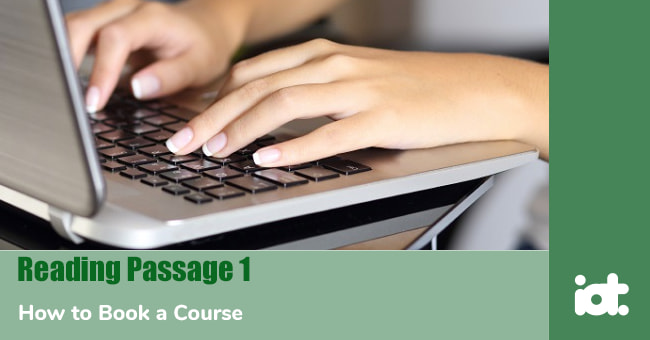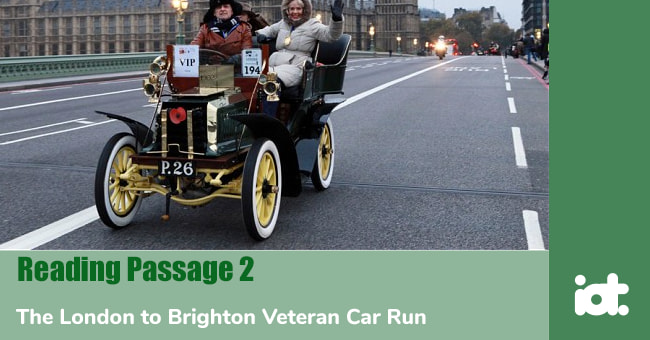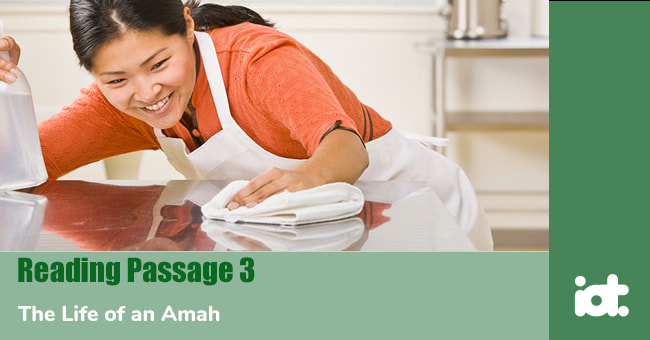Part 1
READING PASSAGE 1

How to Book a Course
Read the text below and answer Questions 1– 6.
If you are interested in joining any of our adult evening classes you can now book in a number of different ways. Online Search for course information online and enrol using our online form. Please upload a passport size photo and pay using any major credit card or PayPal.
Refunds A full refund of course fees will only be made if a class does not start or closes due to insufficient enrolments. Refunds for other reasons are not generally given, but if a refund is granted there will be an administration charge of £5.00. Flexible Learning Centres Adult Education Centres can be found in six towns in Cornwall. Call in to your local Centre or phone for details of opening times and courses available. |
Read the text below and answer Questions 7-14.
| Glen Cottage | |
| Accommodation | up to 2 people |
| Family | no children |
| Parking | 2 cars |
| Distance to the sea | 3 miles |
Reviews: Lots of amazing walks. Fantastic scenery and lovely garden. The property was perfect. There is nothing I would have changed. There is ample parking in the driveway. The owners, who live in the thatched cottage nearby, are very friendly and permit the use of their beautiful landscaped garden. This has some fabulous ponds, shrubs and plants, and guests have the use of a private summerhouse. | |
| Tregonning | |
| Accommodation | up to 3 people |
| Family | no under 2’s |
| Parking | 1 car |
| Distance to the sea | Less than 1 mile |
Reviews: Thank you for the welcome tray and the flowers. The best priced accommodation we have ever stayed in. One week is too short! It really is a home from home with everything we could possibly need provided. By far the best equipped, central, yet quiet. There are three coves that are easy to walk to from the property. Mullion harbour is a delightful example of a Cornish fishing community. | |
| Trevarrow | |
| Accommodation | up to 6 people |
| Family | children/babies OK |
| Parking | no |
| Distance to the sea | Less than 100 yards |
Reviews: This is a great property with a lot of original features, fantastic view, plus all mod cons. Trevarrow has stood above the beach looking out across the sheltered bay since the 1700's. Roadside parking can be found nearby or in the headland car park. | |
Part 2
READING PASSAGE 2

The London to Brighton Veteran Car Run
Read the text below and answer Questions 15–20.
The Bonhams London to Brighton Veteran Car Run starts in Hyde Park, London on the first Sunday in November every year. The cars congregate from 6.00am with the first car departing at sunrise (6.56am) and the last car leaving from between 8.00am - 8.30am. Hyde Park is located in central London and is easily accessible. Cars not associated with the Run and without valid identification will NOT be allowed access to the Park from 5.00am - 12.00pm. Should you wish to show your support at Hyde Park, please enter the park on foot. How to get to Hyde Park If you are using a mobile device, the postcode for the park is W2 2UH. This is for guidance only as the park covers a large area. By Tube The tube stations that surround Hyde Park are: - Lancaster Gate (Central Line) - Marble Arch (Central Line) - Hyde Park Corner (Piccadilly Line) - Knightsbridge (Piccadilly Line) The closest tube station to the VCR start line is Hyde Park Corner. By Bus The buses that stop at Hyde Park are: · North London: 6, 7, 10, 16, 52, 73, 82, 390, 414 · South London: 2, 36, 137, 436 · West London: 9, 10, 14, 19, 22, 52, 74, 148, 414 ● East London: 8, 15, 30, 38, 274 By Car Should you wish to travel by car, there are many car parks located nearby to Hyde Park. The closest car park is situated to the south of Hyde Park and is managed by Q Park. Please contact them directly for prices and location. The open top bus tours give spectators the opportunity to be involved and experience the 60 mile route taken by the veteran cars. You will be able to soak up the atmosphere at the start line with exclusive access to the paddock area and then follow the cars down the whole route. Due to the unpredictable British weather the buses will only be filled to 50 per cent capacity giving everyone the opportunity to shelter on the lower deck in the case of inclement weather. |
Read the text below and answer Questions 21-27.
Peacock Spiders Rather like a 6-pack for men, the male peacock spider tries to impress with decorative, colorful abdominal flaps. The spider begins his courtship by vibrating his peacock-like flaps that reveal a pair of black and white third legs. For female peacock spiders nothing could be sexier but males beware because if their courtship goes too far the female, rather like the black widow spider, might eat its mate. Bowerbirds Male bowerbirds have to be the ultimate home designers of the animal kingdom. To start their courtship they build an elaborate home called a ‘bower’. To make their nest as attractive as possible, bowers have been known to use flowers, berries, seashells, plastic beads, coins, broken glass and even rifle shells. The potential mate can be quite fussy and if not impressed the male will keep adding to his elaborate home to make it more and more colourful. Northern Cardinals The male Northern Cardinal will bring bits of food, usually fish, to the bird they are courting and with a tilt of his head, place a tasty snack into her beak. As if this wasn’t enough, Cardinals will also take part in what is known as counter singing. Each bird, still within its own territory, will sing to each other by matching and repeating phrases together. Chameleons A male chameleon will try to attract a mate by bobbing his head up and down and from side to side to try and get the attention of a potential mate. For males not so sensitive to their progress, the female will show dull colours if she likes him but if not other colours will be shown and he had better run! Frigates In addition to waving their heads, flapping their wings and calling to the females, the males congregate in large numbers and display their vibrant red throat sacs. For about 20 minutes they force air into these throat sacs, which then resemble a large red balloon. If a male has wooed a female, she will simply fly in and land alongside her new mate. Hooded seals Female hooded seals are attracted by males that have the most attractive nasal balloons. Male hooded seals have evolved specialized pinkish-red nasal cavities that they can blow up like bubblegum. To get a female's attention, the male blows up his balloon and starts bouncing it around. The cavities can expand to roughly the size of the seal's head. |
Part 3
READING PASSAGE 3
Read the text below and answer questions 28-40.

The Life of an Amah
Life in China at the beginning of the 20th Century was a very different world than today, especially for women. It was often a very hard life with most women working in the rural areas of China for nothing more than a hand-to-mouth living. For many women in Guangdong province by the Pearl River Delta, however, life was to change forever.
The villages they lived in by the Delta that had once been surrounded by fishponds were now replaced by mulberry trees. This meant large quantities of white mulberry leaves to feed silkworms. This was a chance for many women in the area to grab their independence and they did this by working in China’s now booming silk industry.
It is estimated that over two million women were involved in the silk industry. They took great pride in their independence and refused a conventional lifestyle. They formed sisterhoods and refused to get married, swore oaths of chastity and moved out of their family homes into spinster houses or vegetarian halls as they were called. Some women even held funeral services for a ‘sister’ who had decided to marry.
By the 1930s, however, it was all over. The silk industry had been badly affected by the world depression and many of the once thriving factories were forced to close leaving many women jobless. Some managed to maintain their independence by becoming domestic servants. These were the amahs. By moving to Hong Kong, Singapore and other Southeast Asian countries they could earn enough money (5$ a month) to live a reasonable life and continue their independent lifestyle.
An amahs social life took place in a ‘coolie fong’. This was a 2-3 story building rented by a sisterhood. It was here where she would spend time after her working day was over or on days off. It was a place to relax, share stories with other ‘sisters’, hear about new job opportunities, and collect any letters that had been sent to her from her family in China.
Sisterhoods usually ranged in size from six to ten women but could have up to thirty members. The sisterhood networks helped women migrate from the silk areas of China into cities overseas. Once the ‘sisters’ had arrived in one of these cities, the sisterhoods trained the women in various skills to be a cook, lady's maid or baby amah, and assisted them in finding jobs and in relocating them if their work situation was unsatisfactory. The training provided by the sisterhood usually helped the ‘sister’ become a valued servant and, therefore, to receive the wages she asked for.
In many ways the sisterhood was similar to a primitive labor union in that members established job definitions and minimum wages for each job. If a member was treated badly by an employer, other ‘sisters’ refused to work for the employer. Sometimes one sisterhood dominated the domestic staff of a whole apartment building. In such cases the sisterhood controlled who was hired, and if an employer fired a ‘sister’ without just cause, the sisterhood made it very difficult for the employer to hire another servant.
Sisterhoods also established loan associations for their members, which were especially important for immigrants separated from possible family assistance. The loan associations also acted as investment clubs where the women pooled their savings to buy property where they could retire together.
Every amah had a different routine as this partly depended on the size of the family they were working for and whether they were European or local. Europeans tended to be more demanding. Some households would hire more than one amah but others would only hire one. For many amahs this was a good thing. Although they had to work harder they felt they were more independent and free of typical domestic servant
arguments. These amahs were usually known as “one-leg kick” (or “yat keok tek” in Cantonese) since they did all the work in the household.
A typical workday began when she woke up early in the morning around 5 a.m. and, after getting herself ready, she would start cooking breakfast. After doing the dishes, she swept and tidied up the house. When that was done, she washed the clothes and prepared lunch. After cleaning up, she did the ironing. When that was done, she took a bath. It would then be time to cook again. By the time dinner was over, and she had cleaned up and finished the dishes, it would be about 9p.m. A 16-hour day that was repeated seven days a week with only an occasional half-day off.
Sometimes known as ‘black and whites’ because they often wore white shirts and black pants with their hair in a bun or a long braid falling down their backs, they were seen as an elite group of servants that were hardworking, trustworthy, and completely loyal to the families they worked for.
Stories of their complete loyalty are common with one amah jumping into the sea to rescue her English charge who had accidentally fallen from the ship. Others even worked for free if their employees lost their job and couldn’t pay them. In return the amahs were not exploited but treated like members of the family. Indeed, it was their loyalty that led to them being called amah as the Cantonese word for mother is amah.
Part 1
Questions 1-6
Complete the sentences below.
Choose NO MORE THAN THREE WORDS AND/OR A NUMBER from the passage for each answer.
Write your answers in boxes 1-6 on your answer sheet.
If you decide to book in person don't forget to bring your photo, form, and 1
If you decide to pay by post you can find the 2 online.
If you are having problems booking over the phone we can 3
Regardless of how you book do it a minimum of 4 before.
All of the courses are free from 5
6 is the only reason we would provide a full refund.
Questions 7-14
Complete the summary below.
Choose NO MORE THAN THREE WORDS AND/OR A NUMBER from the passage for each answer.
Write your answers in boxes 7-14 on your answer sheet.
Glen Cottage Despite only accommodating 7 you also have use of a 8 where you can sit in a private summerhouse and enjoy looking at the ponds, shrubs, and plants. Tregonning You really need to go for more than 9 as there is so much to do here. You don’t really need to take anything with you as everything is 10 . If you like 11 then this is the best place to be. Trevarrow Of the three cottages it is the closest to 12 and is the only place where you can take 13 but there is no 14 . |
Part 2
Questions 15-20
Do the following statements agree with the information given in the reading passage?
In boxes 15-20 on your answer sheet, write
| TRUE. | if the statement agrees with the information | |
| FALSE. | if the statement contradicts the information | |
| NOT GIVEN. | If there is no information on this |
15. The first cars arrive when it is still dark.
16. If you arrive by car to watch the race you can park in Hyde Park.
17. The postcode will take you to the exact place in Hyde Park.
18. If travelling by tube then the Central Line gets you closest to the VCR start line.
19. Tea and light refreshments will be provided on the open top bus.
20. Travelling on the open top bus means you will get wet if it rains.
Questions 21-27
Look at the following statements and the list of animals below.
Match each statement with the correct animal, A-F.
Write the correct letter, A-F, in boxes 21-27 on your answer sheet.
| Animals | ||
| A. | Peacock Spiders | |
| B. | Bowerbirds | |
| C. | Northern Cardinals | |
| D. | Chameleons | |
| E. | Frigates | |
| F. | Hooded Seals | |
NB You may use any letter more than once.
21. This male tries to attract a partner by giving her food.
22. This male likes to look for a partner at the same time as many others.
23. This male might end up being eaten if he’s not careful.
24. This male knows if he has been successful or not by the colour of the female.
25. This male likes to do party tricks with his nose.
26. This male likes to think he is a macho man.
27. This male would be a great painter and decorator if he were a man.
Part 3
Questions 28-32
Complete the flow chart below.
Choose NO MORE THAN THREE WORDS AND/OR A NUMBER for each answer.
Write your answers in boxes 28-32 on your answer sheet.
| Sisterhoods usually had up to 28 members |
| Their networks stretched all the way to 29 |
| Sisterhoods offered training in 30 and help in finding jobs |
| A trained amah was able to get the 31 she wanted |
| Sisterhoods acted rather like a 32 controlling salaries |
Questions 33-35
Answer the questions below.
Choose NO MORE THAN TWO WORDS from the passage for each answer.
Write your answers in boxes 33-35 on your answer sheet.
What were silkworms given to eat?
33
Why did many silk factories close?
34
How would sisterhoods help women buy property?
35
Questions 36-40
Do the following statements agree with the information given in the reading passage?
In boxes 36-40 on your answer sheet, write
| TRUE. | if the statement agrees with the information | |
| FALSE. | if the statement contradicts the information | |
| NOT GIVEN. | If there is no information on this |
36. Most Amahs never wanted to marry.
37. Amahs would often get letters from China.
38. Some Amahs were called “one-leg kick” because they were kicked by their owners.
39. Amahs were given a regular day off.
40. Amahs were considered the best of the best.


